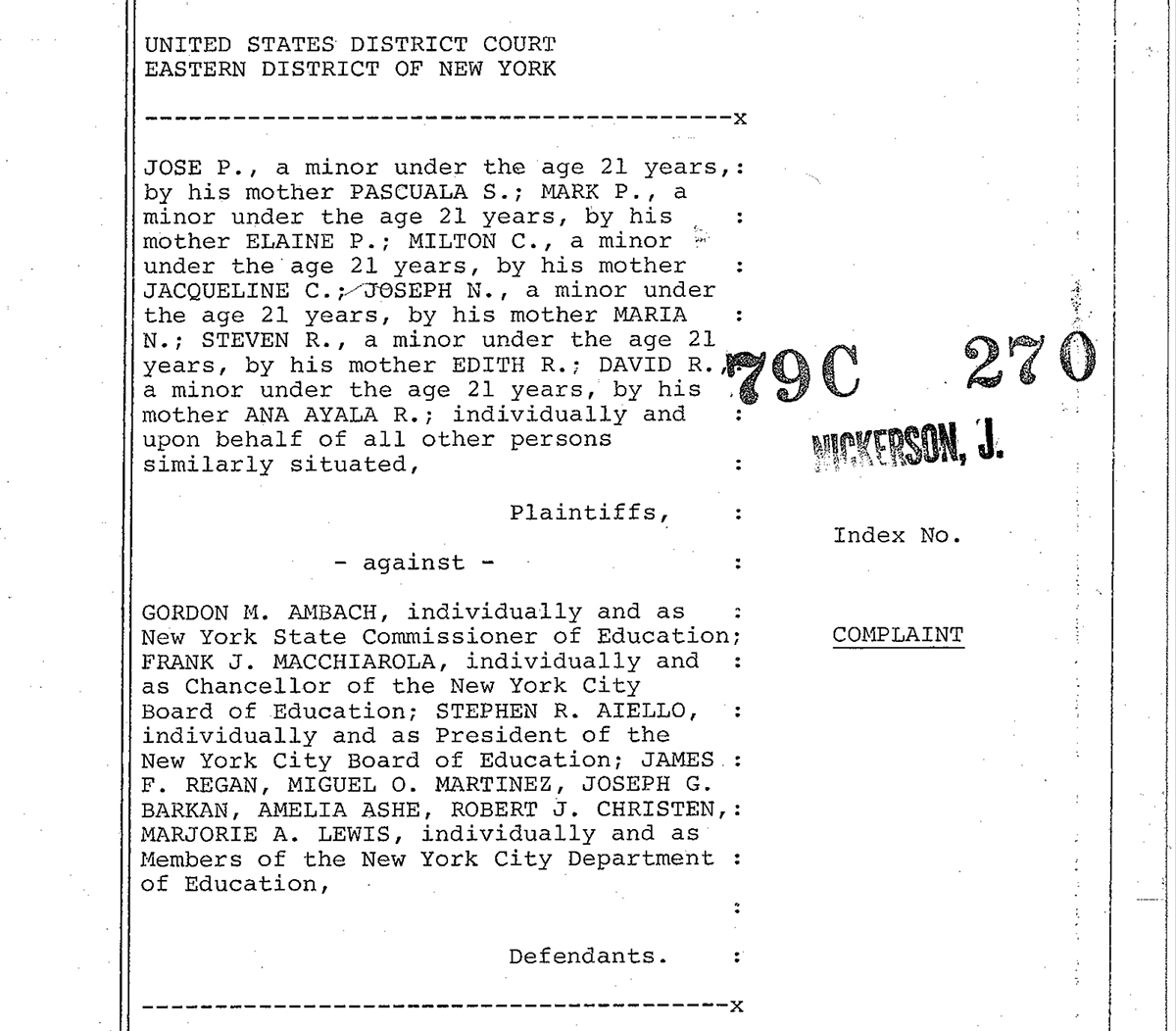Jose P. vs. Ambach, excerpt

Date: Feb 1, 1979
Caption: A group of New York City parents sought legal help and sued to stop the New York City Board of Education from excluding their Disabled children from school.
Many major changes in education have come through federal legislation. The GI Bill of 1944 provided support for college tuition for former soldiers, many who would not have been able to afford it otherwise. Title IX of the Civil Rights Act led to the expansion of women’s access to sports in schools.
But new federal laws don’t lead automatically to changes in what happens in local communities. Often it takes local individuals going to court to get that new law enforced in their community.
That’s what happened in New York City with a new piece of legislation about Disabled students and their education. The Education for All Handicapped Children Act was passed by Congress in 1975. It provided states funding for education for Disabled students, and required that “each state…” “insure that a free appropriate public education is available to all previously identified handicapped children by September 1, 1978, and for all newly identified handicapped children promptly after their identification.”
But as of 1979, there were thousands of Disabled students in New York City who had asked for access to education in New York and nothing had happened.
A group of parents in the Bronx and Manhattan found lawyers from Brooklyn who helped them bring a lawsuit. This document shows excerpts from their formal legal complaint. It explains how the parents and their children argued that New York education officials, including the Board of Education, were violating the law. (Here is the whole complaint, as it looked when the lawyers filed it in court.)
Lawsuits aren’t always successful, but this one was. Federal Judge Eugene Nickerson ordered the Board of Education to locate, evaluate, and create placements for New York’s Disabled students. He required the Board of Education to design processes to ensure that students were evaluated and placed in the “free appropriate public education” that the law provided them.1
The José P. v. Ambach case continued for decades, as many Disabled students continued not to have timely evaluations or appropriate placements and advocates returned to court to push for their rights. The current system for securing special educational services for Disabled children is complicated, slow, and contains many inequities.
The José P. v. Ambach case affected tens thousands of New York students immediately, and millions since. But it is known by the name of one child – José P. Unfortunately, we know very little about José P.’s life before or after he was involved in this case. What did he think of having been excluded from school, and of his family members’ effort to get him access to education? What schooling did he receive after the case? What did he look like, and how did he communicate? There are many thousands of pages of documents related the legal case called José P. v. Ambach, but no images and very few details about José P. as a person. The difficulty of finding José P. in history is one example of a broader problem. Existing historical records make it difficult to see, hear, and understand Disabled people’s lives as they lived and understood them.
-
Jose P. v. Ambach, 557 F. Supp. 1230 (E.D.N.Y. 1983), https://www.advocatesforchildren.org/sites/default/files/on_page/jose_p_judgment_december_1979.pdf?pt=1. ↩︎
Categories: Bronx, Manhattan, parent activism, K-12 organizing
Tags: court cases, Disabled people, Spanish language, disability labels, exclusion from schooling
This item is part of "The Parents’ Movement for Deinstitutionalization and School Access" in "Seeking Equity for Disabled Students"
Item Details
Date: Feb 1, 1979
Creator: John C. Gray, Esq. and Harold Adler, Esq.
Source: Advocates for Children of New York
Copyright: Public domain
How to cite: “Jose P. vs. Ambach, excerpt,” John C. Gray, Esq. and Harold Adler, Esq., in New York City Civil Rights History Project, Accessed: [Month Day, Year], https://nyccivilrightshistory.org/gallery/jose-p-vs-ambach.
Questions to Consider
- How does the complaint describe José P? What else would you like to know about him as a person, and about his life?
- What laws are mentioned in the complaint? What rights do these laws provide to Disabled students?
- Why does the complaint say that it is important for Disabled students to have access to education? Are these the only reasons education matters? What do you think?
- In 1979, was New York City respecting the rights of Disabled students? According to this complaint, what was happening for Disabled students in New York City?
- The Education for All Handicapped Children Act of 1975 established a right to a “free appropriate public education.” The New York State Constitution says that all New Yorkers have a right to a “sound basic education.” What do those phrases mean to you? If you were going to write a phrase to describe what kind of education you deserve, what would it be?
References
How to Print this Page
- Press Ctrl + P or Cmd + P to open the print dialogue window.
- Under settings, choose "display headers and footers" if you want to print page numbers and the web address.
- Embedded PDF files will not print as part of the page. For best printing results, download the PDF and print from Adobe Reader or Preview.
